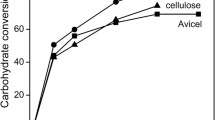Summary
A study on the isoelectric point of lignified cell walls is the subject of this paper. The knowledge obtained can be summarized as follows:
-
1.
The isoelectric point of lignified cell walls is less known; however, it belongs perhaps to one of the most important physical properties of the wood substance.
-
2.
The individual morphological components of the lignified cell wall have their own position of the isoelectric point which corresponds to the chemical composition.
-
3.
Particular chemical constituents of the cell wall are characterized by their own typical position of the isoelectric point.
-
4.
The effect of particular cell wall constituents on the position of the isoelectric point of the cell wall as a whole seems to be differentiated more qualitatively than quantitatively. Their sequence appears to be as follows: pectic substances, lignin, hemicelluloses, cellulose.
-
5.
No substantial differences were found in the position of the isoelectric point of morphological components or chemical constituents of the lignified cell walls with the wood species investigated.
Zusammenfassung
Versuche zur physikalisch-chemischen Kennzeichnung der verholzten Zellwände als Ganzes und ihrer morphologischen sowie chemischen Bestandteile wurden in Form einer Ermittlung des jeweiligen isoelektrischen Punktes durchgeführt. Als Material wurden Querschnitte von Buche (Fagus sylvatica L.) und Pappel (Populus euramericana Guinier cv. Marilandica) im natürlichen Zustand und nach Entfernung jeweils bestimmter chemischer Bestandteile verwendet. Das Meßverfahren beruhte auf der Farbänderung der mit Acridinorange gefärbten Objekte, die mit dem Fluoreszenz-Mikroskop im UV-Licht bei abgestuftem pH beobachtet wurde. Die Ergebnisse sind in den Tabellen 1 bis 3 zusammenfegaßt.
Folgendes konnte festgestellt werden:
-
1.
Der isoelektrische Punkt der verholzten Zellwände ist eine der weniger bekannten, aber dennoch sehr wichtigen physikalischen Eigenschaften der Holzsubstanz.
-
2.
Die einzelnen morphologischen Teile der verholzten Zellwand weisen eine je verschiedene Lage des isoelektrischen Punktes, je nach ihrer chemischen Zusammensetzung auf.
-
3.
Die einzelnen chemischen Bestandteile der Zellwand zeigen eine für sie charakteristische Lage des isoelektrischen Punktes.
-
4.
Der Einfluß der Zellwandbestandteile auf den isoelektrischen Punkt des Zellwandkomplexes ist wahrscheinlich eher qualitativer als quantitativer Art. Die Reihenfolge der Bestandteile ist folgende: Pektinsubstanzen, Lignin, Hemicellulosen, Cellulose.
-
5.
Hinsichtlich der Lage des isoelektrischen Punktes wurde zwischen den untersuchten Holzarten kein wesentlicher Unterschied festgestellt. Wenn sich der isoelektrischen Punkt von Zellwände durch Analogie mit dem isoelektrischen Punkt von Eiweißstoffen erklären läßt, dann müßten die verholzten Zellwände bzw. deren Bestandteile bei einem dem isoelektrischen Punkt gleichen pH ihre niedrigsten Werte hinsichtlich einiger physikalischer Eigenschaften erreichen.
Similar content being viewed by others
References
Brdička, R. 1952. Základy fysikálni chemie (Outlines of physical chemistry). Prirodovêd. Nakl., Praha.
Kinzel, H. 1953. Die Bedeutung der Pektin- und Cellulose-komponente für die Lage des Entladungspunktes pflanzlicher Zellwände. Protoplasma42: 209–226.
Koblitz, H. 1965. Über die Biochemie der Zellwandbildung und den hierfür benötigten Fermentapparat. In: Perspektiven der Grundlagenforschung des Holzes. pp. 39–47. SDVUSVTL, Bratislava.
Nečesaný, V., Morárová, E. 1959. Objemové zmeny bukového dreva. II. Vplyv obsahu celulozy na nasytenie blán a objemové napucanie dreva (Volume swelling of beech wood. II. Effect of cellulose content on cell wall saturation and volume swelling of wood). Drev. Vyskum4: 27–38.
Rendoš, F., Domanský, R. 1966. Studium dusikatych latok dreva. II. Charahter, izolacia a delenie dusikatych latok dreva. (A study of nitrogen compounds of wood II. Character, separation and classification of nitrogene compounds in wood) Drev. Vyskum11: 67–73.
Strugger, S. 1949. Praktikum der Zell- und Gewebephysiologie der Pflanze. Berlin: Gebr. Bornträger.
Author information
Authors and Affiliations
Additional information
The author wishes to devote this paper to the 65th anniversary of Prof. Dr.-Ing. Dr. h. c. Franz Kollmann.
Rights and permissions
About this article
Cite this article
Nečesaný, V. The isoelectric point of lignified cell walls. Holz als Roh-und Werkstoff 29, 354–357 (1971). https://doi.org/10.1007/BF02621436
Issue Date:
DOI: https://doi.org/10.1007/BF02621436




